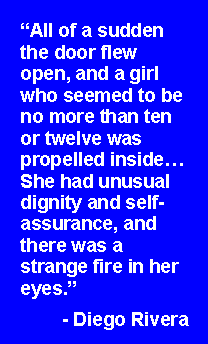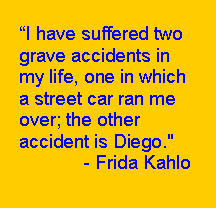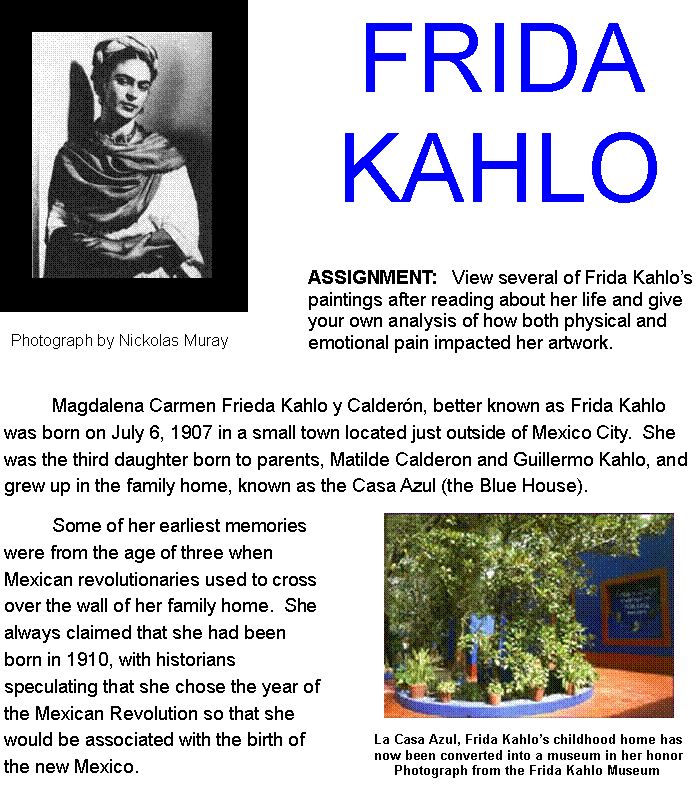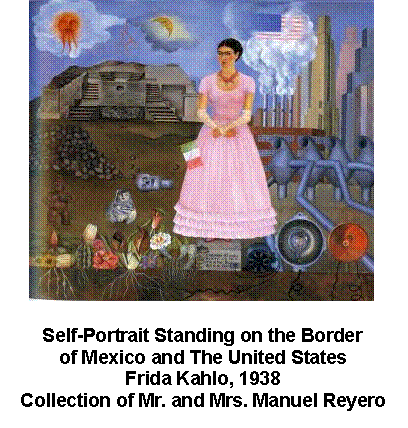
This page is copyright © 2008, C.T. Evans and A. White Del Conte
For information contact cevans@nvcc.edu
|
Web Resources:
A biographical website which also includes a chronological listing of Frida’s more famous works with links to each. A biographical website with photographs and paintings interspersed throughout Counter Punch: Extinguishing Frida Analysis of the movie, “Frida”, and historical information about Frida and polio Biography of Frida Kahlo The Smithsonian Magazine: Frida Kahlo A more detailed biography highlighting Frida’s family, childhood and school years; see also The Official Frida Kahlo Site and The Complete Works of Frida Kahlo Frida’s life as is told through her self portraits with information on each painting Mueo Frida Kahlo Casa Azul (The Frida Kahlo Museum at the Blue House) Information on the Museum itself, as well as links to various paintings Mexico Connect: The Frida Kahlo Museum Biography of Frida Kahlo which also includes a photo strip of several paintings Frida Kahlo Paintings at Walker Art Center Information regarding the Centennial Celebration of Frida Kahlo at the Walker Art Center as well as biographical information |
|
At the age of six, Frida was stricken with Polio which severely stunted the growth in her right leg. She described it in her own words as, “It all began with a horrible pain in my right leg from the muscle downward.” Frida spent nine months confined to her bed during this period, with her father nursed her back to health. As she recovered, her father encouraged her to participate in various sports such as soccer, boxing, wrestling and competitive swimming - uncommon for a girl at that time. |

|
In 1922, Frida entered the National Preparatory School at the age of fifteen. Well known as a fun-loving prankster, the teenage Frida had intentions of becoming a doctor, and studied anatomy, zoology and biology – knowledge that would prove useful in her art in years to come. It was at school at the age of 16 that she first met the man later to become her husband, Diego Rivera. Diego is quoted in his autobiography, My Art, My Life as saying, “All of a sudden the door flew open, and a girl who seemed to be no more than ten or twelve was propelled inside… She had unusual dignity and self-assurance, and there was a strange fire in her eyes.” |
|
On September 17, 1925, more tragedy befell Frida. The bus that she was riding on was hit by a trolley car, killing several people on board. A metal handrail pierced through Frida’s pelvis, her spine was fractured in three places, her pelvis crushed and her right leg and foot were severely broken. The doctors didn’t think she would survive, and the first operation of what would eventually be more than |
|
thirty, offered only temporary relief from the pain. Frida is quoted as saying, “In this hospital, death dances around my bed at night.” It was during her bed confinement that that her mother ordered a portable easel and attached a mirror to the underside of her bed’s canopy – allowing Kahlo to serve as her own model. Even once she was no longer confined to bed, Frida continued to paint herself more often than anything else, stating that she was a subject that she knew better than any other. Using art as her own therapy, Frida’s works frequently depicted her pain, and the surrealistic way she viewed her world. |


|
Reintroduced to famous muralist, Diego Rivera by a shared friend and famed photographer, Tina Modotti in 1928, Diego was immediately fascinated with Frida and later recounted her coming to him and saying, "I have not come to flirt, and even if you are a woman chaser, I have come to show you my paintings." While the bulk of their courtship was held together for their mutual love of art, it was further cemented by their both being strong communist militants, as could be visualized in their work as well as their friendships. The couple married in August 1929. |

|
Frida looked to Diego as an inspiration and spent much time watching him paint, learning and incorporating much of his techniques and colors into her own works. She even tried her hand briefly at creating her own murals, however with few exceptions, preferred smaller works. Early in their marriage, Frida dedicated herself to caring for Diego and stopped painting until his regular infidelities and |

|
her many miscarriages led her to begin working again as an expression of the pains. She later remarked, “I have suffered two grave accidents in my life, one in which a street car ran me over; the other accident is Diego." When Rivero tired of the politics of Mexico, he and Frida officially withdrew from the Communist Party, and traveled to the United States. There Frida continued her primary role as Diego’s flamboyant wife and the couple entertained regularly. While Diego thrived in the US, Frida missed home. One of her better known works, A Self-Portrait Standing on the Border between Mexico and the United States (shown below) was painted during this time. |
|
Other well-known works include My Dress Hangs There, also painted during the Riveras stay in the United States, and The Two Fridas, painted during the year long period during which she and Diego were divorced before remarrying. During her brief lifetime, Frida painted a number of moving paintings, with more than one-third of them being self-portraits. Frida Kahlo died on July 13, 1954 of a pulmonary embolism, although many questioned if she may have committed suicide. Her work has gained in popularity in recent years as Fridamania has swept many. |
|
Timeline of Important Life Events:
1907: Magdalena Carmen Frieda Kahlo y Calderón is born on July 6 in Coyoacán, Mexico (outside of Mexico City) 1914: Stricken with polio. Frida spends nine months bed ridden 1922: Enters the National Preparatory School with plans to become a doctor 1923: Meets Diego Rivera while he is painting at the school 1925: The bus she is riding on is hit by a trolley. Many were killed instantly, Frida is severely injured when a railing breaks off and pierces her pelvis. She also sustains a crushed pelvis, her spine was fractured in three different places and her right leg and foot are severely broken. She is bed ridden for another nine months and begins painting when her mother attached an easel to her bed and had a mirror mounted above her bed 1929: Marries Diego Rivera, 20 years her senior 1932: Moves to Detroit 1933: Moves to New York 1938: Her paintings are shown at the Julien Levy Gallery in New York resulting in her first major sale when Movie star Edward G. Robinson buys four paintings for $800 1939: Marcel Duchamp arranges Paris show. Divorces Diego Rivero 1940: Remarries Rivera 1947: Mexico City's Museum of Modern Art buys "The Two Fridas" 1953: First solo exhibition in Mexico 1954: Dies on July 13th |


|
Recommended Books:
Diary of Frida Kahlo: An Intimate Self Portrait, by Frida Kahlo, Carlos Fuentes and Sarah M. Lowe Frida Kahlo, by Hayden Herrera, Victor Zamudio-Taylor, Elizabeth Carpenter and Kathy Halbreich Frida Kahlo: The Paintings, by Hayden Herrera Frida: A Biography of Frida Kahlo, by Hayden Herrera Frida Kahlo: Life and Work, by Helga Prignitz-Poda Frida Kahlo: The Artist who Painter Herself, by Margaret Frith and Tomie dePaola Frida Kahlo, by Emma Dexter, Tanya Barson, Oriana Baddeley, and Gannit Ankori |


|
1954 |